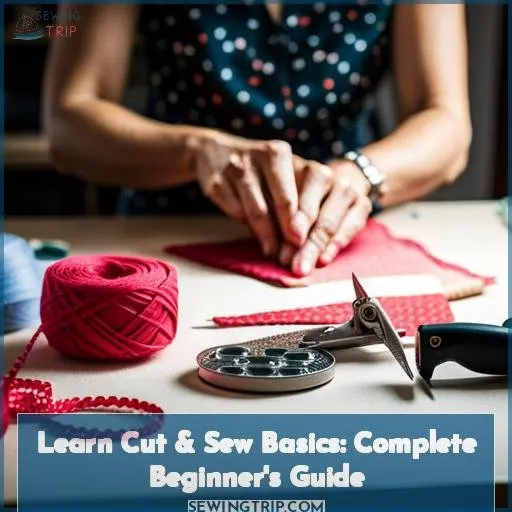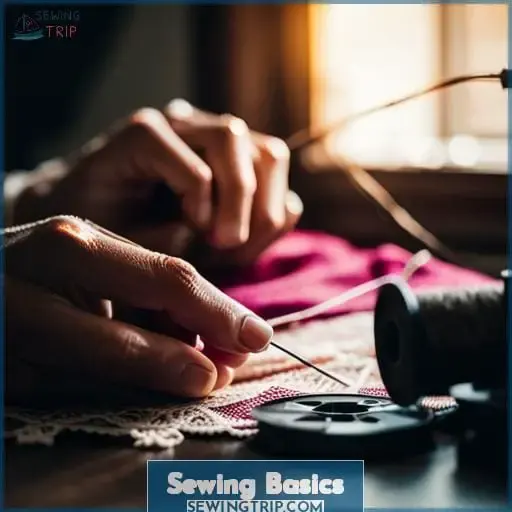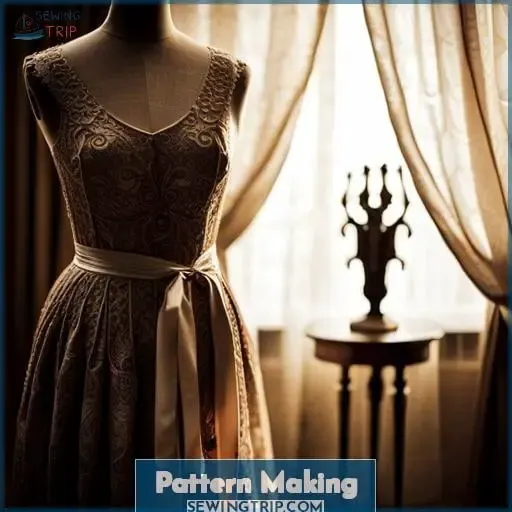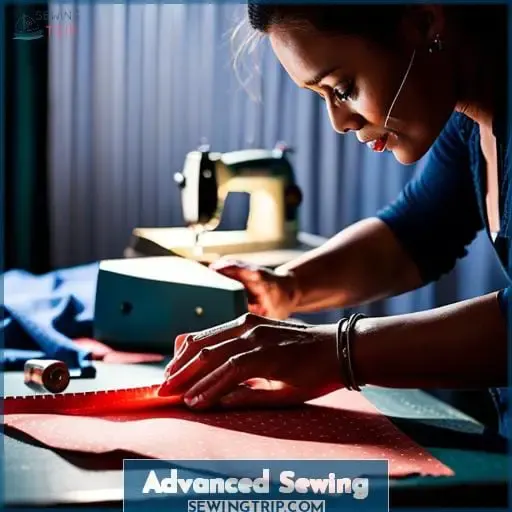This site is supported by our readers. We may earn a commission, at no cost to you, if you purchase through links.
 Did you know that the average American household spends over $1,500 a year on apparel? With the rising costs of clothing, learning to sew and construct your own garments is more valuable than ever.
Did you know that the average American household spends over $1,500 a year on apparel? With the rising costs of clothing, learning to sew and construct your own garments is more valuable than ever.
In this comprehensive guide, you’ll discover everything you need to know to start creating custom, perfectly-fitted pieces right in your own home.
We’ll cover all the sewing basics – from selecting tools and materials to mastering fundamental techniques. You’ll learn to draft patterns from scratch, modify existing patterns, and properly construct seams, hems, and closures.
We’ll guide you through taking measurements, making fitting adjustments, and incorporating advanced skills like tailoring, embellishing, and lining. With practice, patience, and a passion for the craft, you’ll gain the skills to design gorgeous, quality garments that are uniquely you.
Your creations will not only save you money, but provide an outlet for personal expression and deeper connection with others who share your interests.
Table Of Contents
Key Takeaways
- Invest in high quality equipment like a sewing machine, dress form, shears, and iron for the best results.
- Take accurate body measurements for pattern drafting and garment fitting. Make alterations such as adding darts or adjusting ease as needed.
- Choose affordable fabrics, trims, and notions from fabric stores, thrift shops, and vintage outlets to keep costs down.
- Learn fundamental techniques like cutting, pressing, constructing darts, hems, and sleeves.
Sewing Basics
Let’s get down to the basics of sewing, shall we? To get started, you’ll need the right tools – a sewing machine, scissors, pins, needles, a ruler, and tailor’s chalk. Next, choose quality fabrics and notions like thread, zippers, buttons, and interfacing that are appropriate for your project.
Finally, master essential techniques like cutting, staystitching, pressing, constructing darts, setting in sleeves, and hemming.
Tools
You need a good pair of scissors to start cutting and sewing your dreams into reality, hon. Use sharp pinking shears for finishing seams, bias tape for neat edges, and seam rippers and needle threaders for undoing mistakes.
Quality rotary cutters make cutting fabric efficient. Don’t skimp on tools, especially when making samples – they’ll make or break your fabric design and help you shape a perfect sample garment from your paper pattern.
Materials
Pick quality materials because the right fabrics will shape your vision into wearable art, honey. Polyester knits have stretch for comfort, cotton blends feel silky soft, and woven durability makes a trouser zipper sing or a suit jacket pop with princess darts.
Know how each stretch fabric behaves, and read those care instructions before cutting – treat your fabrics right so they can make your dreams come true.
Techniques
- Measure twice, cut once – precision is couture.
- Adjust the presser foot pressure for each fabric.
- Cut fabric on the grain to prevent stretching.
Creating samples and making adjustments will have your garments fitting as if they were made for the runway. With practice, you’ll develop skills to draft patterns and select fabrics until sewing feels like fashion therapy.
Pattern Making
Let’s dive into the magic of pattern making! You’ll start by drafting patterns from measurements or draping fabric directly on a dress form. Next, modify these base patterns to create new designs – add darts, pleats, gathers, and details like pockets.
With creative pattern drafting and draping skills, you’ll bring your custom clothing designs to life in no time.
Drafting
Round these parts, drafting’s where the real magic happens. Bringing designs to life with pattern paper and curves. Didja know over 90% of sewers still draft patterns by hand? With the right tools and some practice, you’ll be bringing sketches to life in no time.
| Tool | Use | Essential Features |
|---|---|---|
| Paper | Drafting patterns | Gridded, durable |
| French curve | Smooth lines | Range of curves |
| Scale ruler | Precise measurements | Industry standard |
| Wheel | Curved edges | Smooth rotations |
| Pins | Temporary holds | Rust resistant |
| Weights | Keeps paper flat | Non-slide |
With quality tools and dedication, you’ll craft patterns to bring your visions to life. Each step moves you closer to that final garment. Stay focused on your goals, and let your creations take shape.
Draping
Before you start draping, grab some muslin and a dress form. Drape that fabric right on the form to see your design come to life! Choose fabrics wisely, my dear. Be mindful of drapey knits and prints. Mark the grainlines so you don’t get twisted.
Try different finishes for clean seams. With care and time, your quality garment takes shape.
Modifying
Make quick changes, dear, to perfect the fit. Tweak those darts and add some ease, but don’t lose shape as you tailor with care. Shorten a sleeve, slash for flare, take in the waist to define your shape. Vary those proportions for a custom fit.
Substitute wovens for prints—hands of professionals craft quality garments with creative flair.
Garment Construction
As a fashion designer and sewing instructor, I am thrilled to guide you through the essential garment construction techniques. We will start by exploring the magical world of seams—the stitches that connect fabric pieces together into 3D garments.
Then we will tackle hems, which add polished, professional finishes. Finally, we will stitch on closures like zippers, buttons, and snaps to complete your unique creations.
Seams
You’re stitching those seams together now, bringing the fabric pieces into a whole garment.
- Hidden seams inside garments for clean finishes.
- Flat felled seams for durability on straight seams.
- French seams fully enclose raw edges.
- Bound seams add a decorative trim.
- Welts strengthen high-stress areas.
With the right stitches in the right places, your custom threads will hold together in fabulous fashion.
Hems
So long hemlines, folks! You’re finishing those fabulous frocks with finesse now. Carefully turn up and press your hems before sewing by hand or machine. For discreet hems, try narrow blind-stitched hems.
Or showcase your skills with a tidy rolled hem. Whatever your preference – french, hand-sewn, or machine-stitched – quality hems neatly finish your custom cut and sewed creations.
Closures
After zipping up those killer skirts, you’ll be buttoning up blouses and snapping shirts closed in a snap. Secure closures like chunky zippers, lustrous buttons, velcro, and gleaming snaps let you style and fasten your custom cut and sewn threads.
Ensure quality by sourcing durable closures from reputable manufacturers. With reliable zippers and buttons, your garments will snap, zip, and click closed with ease.
Fitting Adjustments
When creating custom-fit garments, precise measurements and thoughtful alterations are essential. To start, taking accurate body measurements is the crucial first step for pattern drafting and garment fitting.
Next, we’ll explore common adjustment techniques like shortening hemlines, reducing waistbands, and tapering sleeves to achieve the perfect personalized fit. With the right measuring and alteration skills, you’ll have the power to create garments that flatter your body beautifully.
Taking Measurements
Getting precise measures is mission critical for flawless fits when designing made-to-measure garments. Carefully note the client’s height, bust, waist, hip, sleeve length, and other key dimensions. Use a professional measuring tape, avoid pulling too tight. For tricky areas, have them try on a close-fitting tank top and leggings.
Mark directly on the garments with tailor’s chalk. Take photos from all angles to check proportions. Compare to standard size charts, considering ease needed. Pattern upscaling requires precision. With accurate data, you can adjust the blocks to fit like a glove. Body scanning technology captures details digitally for bespoke designs.
Though determining measurements takes time, it enables exact custom clothing for all shapes and sizes.
Making Alterations
You’ll nail the fit by carefully tweaking the pattern pieces before cutting fabric. Pinning up a muslin, mark problem spots with tailor’s chalk. Taking in the side seams nips the waist; open the shoulder seams to raise the armholes.
Shortening the sleeves by folding out length. Lowering the darts reshapes the bust; curve the princess seams to fit curves. Overseeing manufacturers through a couple of fittings perfects difficult areas. Don’t overlook little details that make all the difference in fit and quality.
Advanced Sewing
Let’s dive into essential tailoring techniques like canvas interfacing to shape structured garments. Add decorative embellishments such as applique and beadwork to create visual interest. Use clean finishing with lining fabrics to conceal messy insides. These methods will give your sewing an elevated, professional polish.
With practice, you’ll soon master constructing couture-quality garments that fit perfectly, look flawless, and impress even the most discerning sewist.
Tailoring
Tailoring brings your vision to life as you shape fabric into couture. Like Michelangelo chipping away at marble to reveal David, your keen eye and steady hand transform flat cloth into striking silhouettes that honor the human form.
With each stitch, you sculpt garments that embrace your clients’ curves. Your expert patterns and precise seams craft both precision and comfort. Hands caress custom linings, fasten ethical, handmade buttons, and discover quality craftsmanship.
Sustainable packaging protects your custom cut and sewn creations, extending these tailored treasures from studio to home.
Embellishments
With intricate beading and lavish embroidery, you decorate your garments with handcrafted elegance.
- Choose beads, sequins, or rhinestones.
- Select threads and needles.
- Outline designs with pins or chalk.
- Hand sew each piece into place.
Your adornments transform fabric into art. Intricate stitches shape petals, crystals catch light, and beadwork sculpts new dimensions. These touches turn dresses into masterpieces, elevating your vision through painstaking details stitched with care.
Lining
Slipping a sumptuous lining into your garment softens seams against skin for a luxurious finish. Selecting a smooth, breathable fabric like silk or satin prevents wrinkles while smoothing inner seams. Hand stitching the lining to cover raw edges prevents fraying. With quality materials and appropriate training, you’ll craft an exquisite interior to secretly delight in.
Frequently Asked Questions (FAQs)
What sewing machines and other equipment do I need to get started?
Invest in an industrial sewing machine, dress form, fabric shears, pins and needles, a serger, an iron, and a large cutting table. Quality equipment allows you to handle delicate fabrics and construct durable garments with clean finishes.
Where can I find high-quality, affordable fabrics and trims?
Check fabric stores like Mood Fabrics or discount shops for affordable options. Thrift and vintage shops can offer unique, high-quality finds too. For trims, look for sales and coupons at craft stores. EBay and Etsy sellers have deals on pre-packaged trim assortments.
How do I price my custom or small-batch cut & sew garments?
Value your time and skills. First, calculate material costs. Then, estimate labor hours at $20-50 per hour based on complexity. Multiply by 2-3 for a profit margin. Keep sample costs low to entice orders. Your one-of-a-kind creations deserve fair pricing.
What are some common fitting issues and how can I adjust my patterns to fix them?
Here are a few tips to fix common fitting issues. To start, pinch any extra fabric at the seams to see where to take it in. If the waist gapes, either take in the waist or raise the waistline. For gaping armholes, make the arm curves deeper.
An uplifted bustline indicates grading down cup size. Making these simple adjustments will perfect the fit.
How do I market and sell my cut & sew clothing line?
Photograph your collection on real people, telling their stories. Promote through social media, pop-ups, and trunk shows. Connect personally – share behind-the-scenes, answer messages. Give back, collaborate.
Conclusion
You now have expert knowledge on cut and sew basics! Don’t be intimidated by how to cut and sew. You’re ready to start making your own custom garments. With the sewing fundamentals, pattern making, construction, fitting, and advanced techniques covered here, your creative visions can come to life! Confidently cut fabric and stitch original designs.
Share your talent by teaching friends, selling pieces online, or opening a boutique. When you have the skills to cut and sew anything you imagine, the opportunities are endless.










